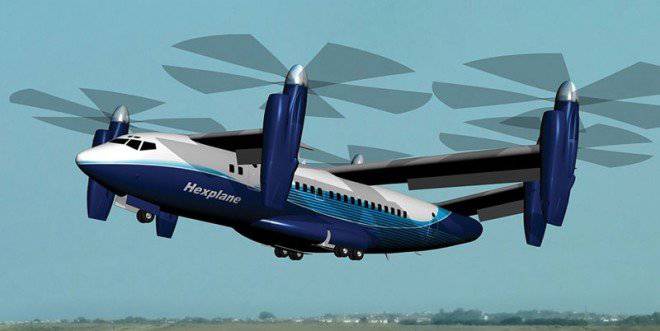Oliver Hexplane. Six screws for reliability
The solution proposed by the American aircraft designer Richard Oliver should be the solution to this particular problem. His firm Oliver VTOL is now finishing work on a project for a new aircraft, called the Hexplane. Its main difference from other vertical take-off and landing vehicles and, according to Oliver, the advantage is the number of engines and propellers. Osprey has two of them, and Hexplane has six of them. Due to this, the reliability of the equipment and, as a result, the safety of flights must be increased.
Six propeller units are located on the front horizontal tail, the main wings and the tail stabilizer Hexplein. The rotation of the blocks is carried out synchronously and in pairs, so that the device can take off like a helicopter and fly in an airplane. Turboprop engines are supposed to be used as a power plant; however, for obvious reasons, power and a specific type have not yet been named. Probably, in Oliver VTOL, until now, they themselves have not decided on this issue. Nevertheless, it seems that designers have considerations about engine power. Otherwise, they would hardly have called the approximate characteristics that should be expected from the Hexplane. The vehicle’s actual ceiling should be at the 24-25 thousand feet (7300-7600 meters), cruising speed of about 420-430 miles per hour (675-690 km / h) and a distance of more than two thousand miles (from 3200 km).
The first flight of the Hexplane will have half the range and a smaller ceiling. You can understand the designers - it will be necessary to work out a new scheme of the aircraft, which in itself is not a simple and slow task. Therefore, to start in Oliver VTOL will be small. With a take-off weight of 6,5 tons, the first Hexplein will have a carrying capacity of just a thousand pounds (about 450 kg). But the authors of the project hope to interest potential customers with a small demonstrator, and then start developing more large six-screw devices.

It can be seen that the stated characteristics of the product Oliver VTOL do not stand out strongly from the existing technology. The payload of Heksplein is no more than that of helicopters, and they lose speed in transport aircraft. What, then, is Oliver wanting to interest potential customers? The argument is the same as that of the creators of the V-22 Osprey: aircraft speed with helicopter take-off and landing capabilities. However, the creation of the company Bell has only two engines, which reduces survivability, limits maneuverability, etc. According to R. Oliver, his Hexplane is almost completely free from these problems. Thanks to the six propeller groups, the failure of one or two of them allows the flight to continue on the rest, albeit with appropriate restrictions. The fact that the center of gravity of the device is inside the “ring” formed by engines and screws is particularly emphasized. It is this, as they say in Oliver VTOL, that allows the tiltrotor to not have serious problems with stability when losing one of the screws / motors. Also, Heksplein is not afraid of damage to one of the wings, and if two wings or three or more engines break down at once, the device can sit in a helicopter mode in autorotation. In addition to the issues of vitality, the creators of the six-screw machine also attract customers with economic figures. With modern engines, the Hexplane consumes less fuel on the 15-20 than the V-22 has at equal payload.
According to rumors, the project of R. Oliver has already received approval at the Pentagon, and the military are now looking for ways to allocate the appropriate amount for the continuation of work. Required works are estimated at 12-13 million US dollars. There is also every reason to believe that Heksplein might be interested in the DARPA agency, which is “looking for” an aircraft of vertical take-off and landing with a ceiling of at least 7 thousand feet and a cruising speed of about 700 km / h.

Information